
table of contents
- Wood colors according to wood types and their use
- Deciduous trees
- Conifers
- Precious woods
- frequently asked Questions
Wood, regardless of its type, is a living natural product and each one is unique. The grain and color of the different types of wood are also individual, as are their possible uses.
In a nutshell
- Wood types are very varied in terms of color and grain
- Wood colors range from whitish and yellow to reddish to brown and blackish
- For wood types with heartwood, the main color refers exactly to it
- Structure or The grain can be coarse, fine or almost non-existent
- Woods like pine, Spruce and larch have so-called resin passages
Wood colors according to wood types and their use
Deciduous trees
Maple (acer)
- The most important European representatives are sycamore and Norway maple
- The lightest type is the sycamore maple
- Yellows over time
- Norway maple varies between yellowish and slightly gray tones
- Field maple is a bit redder
- No visible demarcation between sapwood and heartwood
- Fine light brown lines and fine-pored, homogeneous structure
- Thanks to its strength and elasticity, it is used in furniture production and as flooring
- Not suitable for outdoor use
- Hardly weather-resistant, tendency to fungal attack

Tip: Sapwood is the sap-bearing wood directly below the cambium (growth layer between the sapwood zone and tree bark). Heartwood is by no means unusable because it is more resistant, harder and more durable than sapwood.
Pear tree (pyrus communis)
- Wood colors evenly light, yellowish to reddish brown
- Darkening under the influence of light
- Hardly recognizable annual rings, numerous rays
- Very fine and numerous pores
- Sapwood and heartwood cannot be distinguished when dry
- Usually not a real color core
- In older trees, partly brown-purple, irregular core
- Birch wood does not work and is very stable
- Special feature: good wood carving
- Used for furniture production and for veneers
- For building tools and musical instruments
- Special feature: flamed veneers of particularly high quality
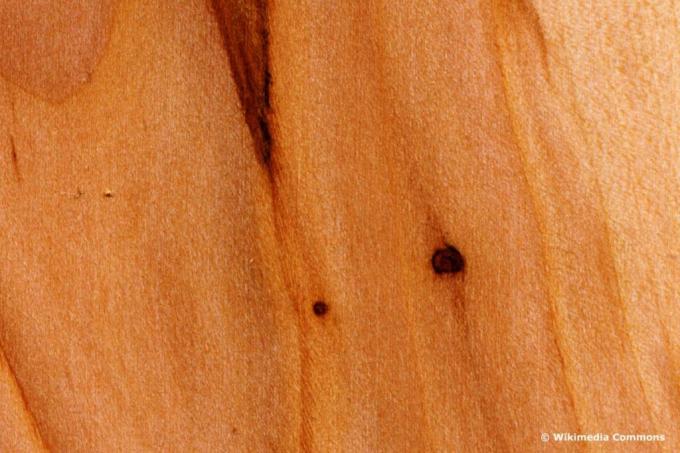
Birch (betula)
- Mostly pale yellowish to reddish white sapwood
- Also brownish in older trees
- Color darkens quickly
- Grain, hardly noticeable light lines, partly flamed
- Birch wood from Finland of particularly high quality
- Special grain in the form of an ice birch pattern
- Birch wood is generally soft, elastic, not weather-resistant
- Use as veneer, flooring, ceiling and wall paneling
Tip: Red spots in the wood are not unusual, but can indicate an insect infestation.

Beech (Fagus)
- Reddish white to light reddish color, fine, even texture
- Sapwood and heartwood can hardly be distinguished
- Sapwood takes up the entire trunk cross-section
- From the age of 80, formation of an irregular (optional) red core
- Not weatherproof, very susceptible to fungal and insect infestation
- Use as veneer, for plywood production, for seating
- In particular for parquet, in stair construction, household items
- Not suitable for damp rooms and outdoors

Oak (Quercus)
- Mostly narrow split yellowish-white to light gray
- Heartwood light or honey yellow, gray yellow to light brown
- Darkens yellow to dark brown under the influence of light
- The sapwood and core are clearly separated from each other
- Pronounced pore grooves, distinctive wood rays (medullary rays), clearly structured
- For windows, doors, as stair wood, for veneers and for furniture production

Alder (Alnus glutinosa)
- One of the types of wood without real heartwood
- Fresh wood pale yellowish to light reddish-white
- Darkens to reddish brown
- Annual rings of different widths
- Very fine and scattered pores
- Rays arranged at irregular intervals
- The impression of a broad wood beam is created (pseudoplasm beam)
- Use as plywood, for carving, for carpentry and turning
Tip: A special feature of the alder is that it is very durable under water, while it is actually not weather-resistant.
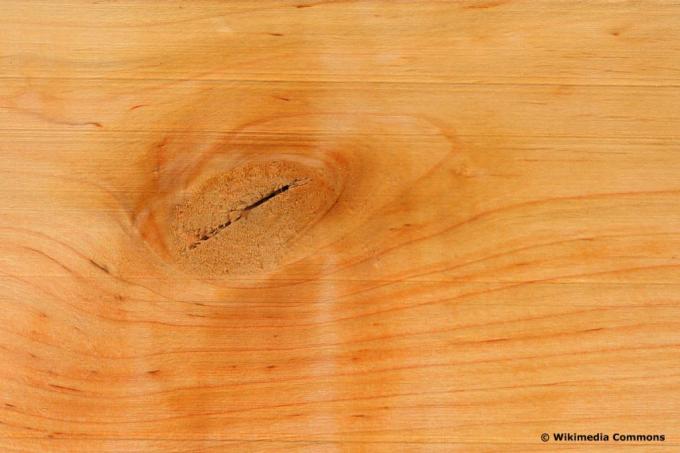
Ash (Fraxinus excelsior)
- Wood colors from creamy white to light brown
- Sapwood white, with age also reddish or brownish
- Not clearly distinguishable from the heartwood
- The core is sometimes dark brown or black
- Straight, fibrous, coarse structure, with decorative markings
- Often cloudy or irregularly streaked
- Annual rings clearly visible
- Use indoors, as parquet, veneer and for furniture production

Hornbeam / White Beech (Carpinus betulus)
- Wood colors over the entire cross-section yellowish-white to light gray
- Fades in bright light
- Old trees are often irregular and brownish
- Rays large, irregularly distributed
- The heaviest wood of all domestic timber types
- High wear resistance
- Not very durable outdoors
- For heavily used, small-sized objects (chopping blocks, clamps, etc.)

Linden tree (Tilia cordata)
- The sapwood and core are mostly yellowish-white
- Sometimes slightly reddish tones
- Limewood tends to turn green and turn blue
- A striking feature is the silky sheen
- Fine, even, very dense drawing
- Rays are far apart
- Bright border of the annual rings clearly visible
- Mainly used in handicrafts, for making instruments and for toys

Poplar (Populus)
- The core and sapwood of black poplar and their crossings are colored differently
- White poplars no differences in color
- Wood colors from white-yellowish to gray-yellowish to brownish
- The core of the black poplar is slightly greenish in places
- Otherwise light brown to reddish brown
- Structure fine-pored, homogeneous, simple
- Not weatherproof, robust against wear and tear
- For interior work, baskets, fruit crates, packaging, benches, wooden loungers, roof shingles
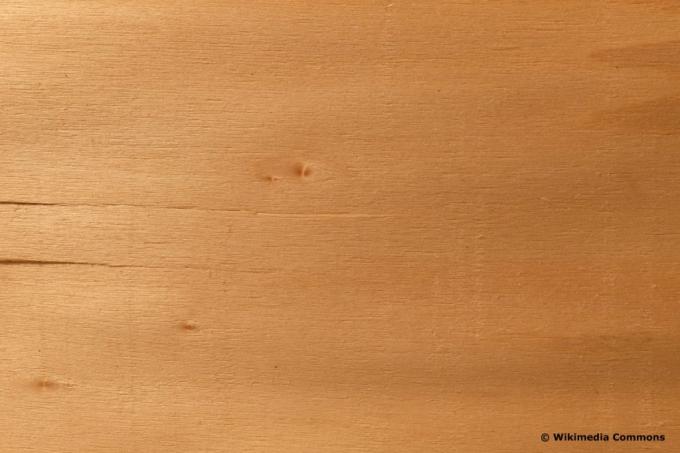
Black locust (Robinia pseudoacacia)
- Heartwood yellowish green, olive brown or golden brown
- The sapwood is light yellow, clearly delimited from the core
- Pores large and ring-shaped
- Annual rings clearly visible
- Matt silky shine
- Use as construction timber, for fences, masts, in boat building
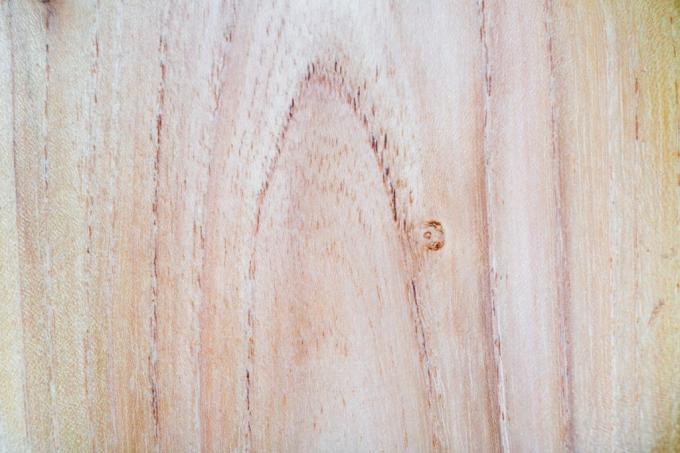
Conifers
Douglas fir (Pseudotsuga menziesii)
- Has white to yellowish-gray sapwood
- Narrow to wide, depending on the age of the tree
- When fresh, it clearly separates itself from the heartwood
- Core yellow-brown to reddish-brown, clearly darkening
- Broad annual rings at a young age
- Small, barely visible, scattered resin channels
- Contain a very volatile resin
- Gives fresh wood a sharp, aromatic smell
- Suitable for outdoor and indoor use
- Use in horticulture, for floors, stairs and veneers

Spruce (Picea abies)
- Wood colors vary between yellowish-white and yellow-brown
- Sapwood and heartwood cannot be distinguished in terms of color
- Have a natural shine
- Straight-grained wood, with a fine texture, very resinous
- Annual rings clearly visible
- Less prone to wood stain than the pine
- The most commonly used building and construction timber
- Indoors for floors, cladding, built-in furniture and saunas
- For windows, fences, gates, facade cladding

Pine (Pinus sylvestris)
- Outer sapwood shimmering yellowish-white
- Heartwood red-brown, slightly resinous
- Annual rings and resin canals clearly visible
- Texture varies between fine and coarse depending on the location
- Used for doors, windows, furniture, ship and bridge construction, veneers, construction wood
- Resin is used to extract turpentine
Tip: The sapwood is particularly susceptible to blue stain and the heartwood is moderately resistant to wood-destroying fungi.
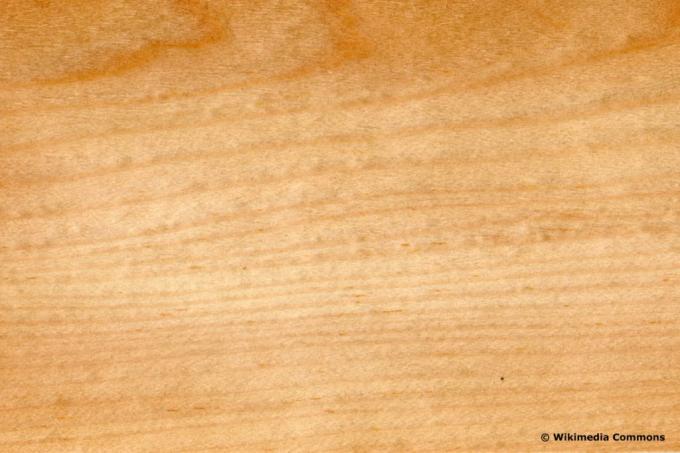
Larch (Larix decidua)
- Narrow, pale reddish sapwood
- Heartwood from yellowish to reddish to orange-brown
- Darkens strongly when exposed to light
- Straight-fibrous, with pronounced annual rings
- Small resin canals, only visible with a magnifying glass
- Durable even if left untreated outdoors
- Mainly used in gardening and landscaping
- And for floors, windows, interior doors, paneling

Fir (Abies alba)
- Sapwood and heartwood cannot be distinguished in terms of color
- Wood colors from matt reddish to yellowish-white
- Often with a gray-purple tint
- Resin canals are missing, and medullary rays are also barely visible
- Fine texture, straight-fibred
- Wood susceptible to beetle infestation
- Use in interior work, construction, scaffolding, for boxes and pallets
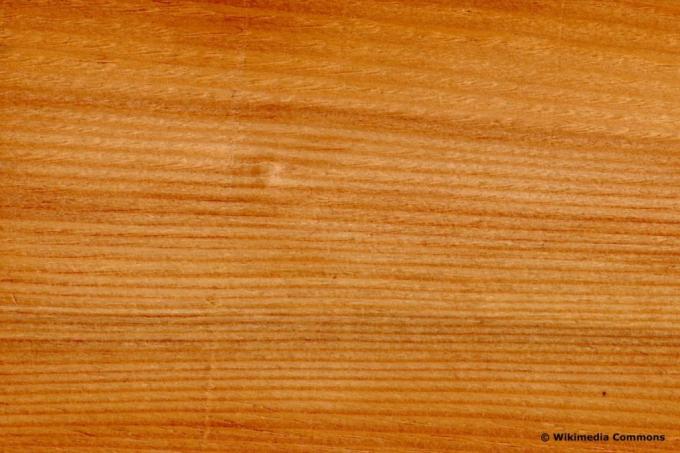
Precious woods
Boxwood (Buxus sempervirens)
- Minimal color differences between sapwood and heartwood
- Visible only when wet
- Dry, evenly yellowish-white to waxy yellow
- Only slightly darkening in light
- The grain is straight, very irregular in places
- Rays hardly recognizable
- Use restricted to handicrafts
Cherry tree (Prunus avium)
- Precious wood with pale yellowish-white sapwood and reddish-brown heartwood
- Particularly beautiful grain
- Annual rings often have a gray and greenish border
- Very dense pore rings in young wood
- Loosely distributed in older wood
- Use in furniture construction, paneling, veneers, parquet, small home accessories

Mahogany (Meliaceae)
- No native wood
- Color of the sapwood is yellowish-gray or light gray
- Heartwood light, often reddish to dark reddish brown
- When exposed to light, it takes on a dark brown color
- Medium to large pores, fine wood rays
- Fiber orientation predominantly alternately twisted
- Use in window construction, for cladding, furniture, frame constructions

Walnut (Juglans regia)
- Usually walnut wood
- Heartwood from walnut with a matt brownish to black sheen
- The outer sapwood has a whitish to pinkish-gray color
- Wood colors differ depending on the tree, location and age
- Grain growth, color and structure partly wild
- Annual rings clearly visible
- Used for turning, furniture, veneer
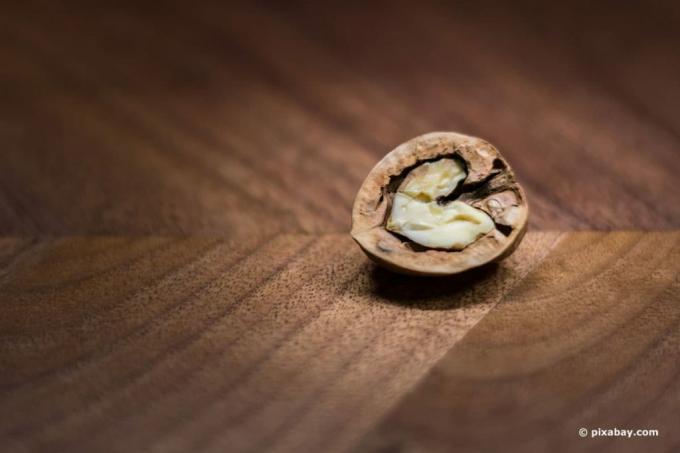
Teak (Tectona grandis)
- Teak, a pure imported wood
- Rather light sapwood, whitish to light gray
- Often very wide in young trees
- Dark golden brown heartwood, darkens in the air
- Straight grain with uneven, coarse texture
- High weather resistance, flame retardant
- Use in furniture and shipbuilding, windows, door frames, terraces, panels, arts and crafts

Cedar wood (Cedrus atlantica)
- Cedar sapwood very light, almost white
- Heartwood light brown to reddish brown
- Big color differences between early and late wood
- Clearly recognizable growth rings
- Depending on the type, the grain is straight or very irregular
- Use for parquet, less often as construction timber, in interior construction or for furniture production
Tip: The cedar tannins are special because they react with iron. The wood can discolour bluish gray, but this is only a visual impairment.
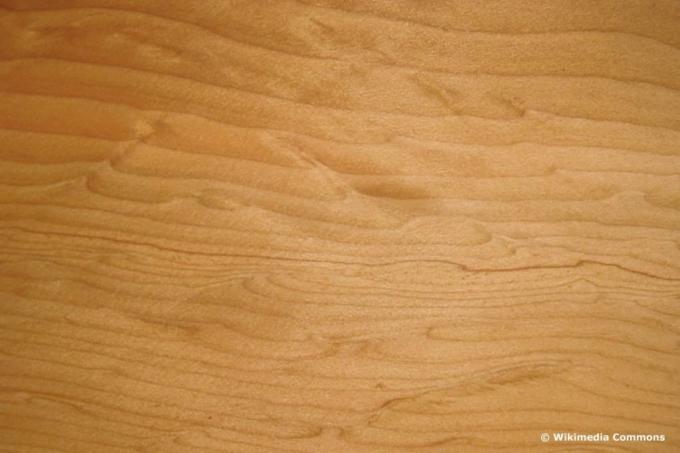
frequently asked Questions
The color is mainly influenced by the influence of light, temperature, humidity and location as well as by different treatment methods.
Differences in color, even within one type of wood, as well as differences in grain and structure, are part of the natural properties of wood and in no way represent a quality defect.
Warm and light wood colors such as birch and maple can be combined very well with each other. Dark colors such as cherry, oak or walnut also go wonderfully together. It is important to have a similar color cast, not necessarily the same color. Another clue is the grain. So z. B. Combine woods with a similarly coarse grain perfectly.



